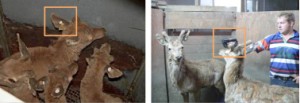An overview of research carried out on using EPC UHF RFID standards to identify, capture and share information throughout a real-life eleven stage process in the New Zealand venison industry
by Gary Hartley, NZ Pathfinder Group
 Radio frequency identification and related technologies are seen as tools for identification and traceability purposes in the food and food production and distribution sectors. The researchers used the technologies to investigate the movement of live deer from a farm and a venison processing plant and then exporting of cartons of finished venison cuts by ocean freight to Europe and their delivery to a retail location in Hamburg, Germany. The findings corroborate those of other research indicating that EPC standards and specifically the EPCIS standard are effective tools for enhancing supply chain visibility and traceability.
Radio frequency identification and related technologies are seen as tools for identification and traceability purposes in the food and food production and distribution sectors. The researchers used the technologies to investigate the movement of live deer from a farm and a venison processing plant and then exporting of cartons of finished venison cuts by ocean freight to Europe and their delivery to a retail location in Hamburg, Germany. The findings corroborate those of other research indicating that EPC standards and specifically the EPCIS standard are effective tools for enhancing supply chain visibility and traceability.
Prompted by their constituents and by their own concerns about safety, governments in Europe and in the United States in particular have been drafting laws requiring various degrees of traceability, especially in the food industry. In New Zealand, the National Animal Identification and Traceability (NAIT) organisation has recognised that worldwide lifetime identification and traceability of livestock and domestic animals is becoming increasingly important for a number of reasons, including trade and market access, management of livestock diseases and providing assurance to consumers that their food is safe and of the highest quality (NAIT 2008 p.1). These new regulatory requirements are creating more demand for traceability than ever before. Companies need systems that can provide end-to-end traceability, with accurate information and precise identification of the products and services, locations and actors involved.
 There is general recognition and acceptance in New Zealand that its trading partners will make the existence of credible systems that provide whole-of-life tracing of animal products a major factor in their decisions on which countries or suppliers they purchase from. NAIT has stated that the driving force behind the NAIT system is the necessity to make individual animal identification and tracing work for the good of all participants and to protect New Zealand farmers in the market place while ensuring New Zealand is positioned well in the event of a biosecurity incursion (NAIT 2008 p.2).
There is general recognition and acceptance in New Zealand that its trading partners will make the existence of credible systems that provide whole-of-life tracing of animal products a major factor in their decisions on which countries or suppliers they purchase from. NAIT has stated that the driving force behind the NAIT system is the necessity to make individual animal identification and tracing work for the good of all participants and to protect New Zealand farmers in the market place while ensuring New Zealand is positioned well in the event of a biosecurity incursion (NAIT 2008 p.2).
Radio frequency identification (RFID) has been identified as a technology that will not only speed the process of data collection but will ensure accuracy (NAIT 2008). New Zealand mandated the use of RFID technology for cattle in 2012 based on ISO standards, NZ/ISO 11784:2001 & 11785:2001.1 for transponders (low frequency RFID) and a numbering system to identify animals compliant with the International Committee on Animal Recording (ICAR) requirements. The use of RFID technologies will be mandated for other species in the coming years; Deer are scheduled for inclusion in 2013. NAIT may assess and endorse devices containing transponders, which are not NZ/ISO 11784:2001 / NZ/ISO 11785:2001 compliant on a species by species basis.
The EPCglobal Network is a secure means to connect servers containing information related to items identified by using globally unique numbers known as Electronic Product Code (EPC) numbers. The servers, called EPC Information Services (EPCIS) are linked via a set of standards- based network services and the internet. EPC standards and the EPCglobal Network are being used around the world to provide supply chain visibility and traceability.
Research
 As with earlier Pathfinder research into the use of RFID technology within the context of livestock identification and traceability outcomes, the research carried out in this project used Ultra High Frequency (UHF) RFID technologies (tags and readers) in conjunction with EPC identification and network standards; part of the broader EPC suite of standards. This research was conducted over a period of six weeks from late October to early December 2012. Using an eleven (11) stage process design model, stage one (1) saw UHF ear tags encoded with EPC unique identification numbers attached to the ears of a sample population of twenty (20) deer that were being farmed in Geraldine, New Zealand. One animal escaped from the mob while on farm so that the sample population was nineteen (19). The remaining research stages outlined the transport of animals from the farm by road transport to a processing plant in Rakaia, New Zealand where the deer were processed into chilled venison cuts, packaged into cartons and exported by ocean freight in a refrigerated container for delivery to retail locations in Hamburg, Germany.
As with earlier Pathfinder research into the use of RFID technology within the context of livestock identification and traceability outcomes, the research carried out in this project used Ultra High Frequency (UHF) RFID technologies (tags and readers) in conjunction with EPC identification and network standards; part of the broader EPC suite of standards. This research was conducted over a period of six weeks from late October to early December 2012. Using an eleven (11) stage process design model, stage one (1) saw UHF ear tags encoded with EPC unique identification numbers attached to the ears of a sample population of twenty (20) deer that were being farmed in Geraldine, New Zealand. One animal escaped from the mob while on farm so that the sample population was nineteen (19). The remaining research stages outlined the transport of animals from the farm by road transport to a processing plant in Rakaia, New Zealand where the deer were processed into chilled venison cuts, packaged into cartons and exported by ocean freight in a refrigerated container for delivery to retail locations in Hamburg, Germany.
 The researchers elected to incorporate an additional dimension into research by using active RFID tags (data loggers) Xsense to monitor the temperature of individual cartons during the transit from the processing plant to delivery in Hamburg. In addition to this, the movement of the shipping container was also tracked using Global Positioning System (GPS) technology. Both these elements were managed by Israeli company BT9, an organisation that provides end-to-end cold chain management (CCM) technology and solutions.
The researchers elected to incorporate an additional dimension into research by using active RFID tags (data loggers) Xsense to monitor the temperature of individual cartons during the transit from the processing plant to delivery in Hamburg. In addition to this, the movement of the shipping container was also tracked using Global Positioning System (GPS) technology. Both these elements were managed by Israeli company BT9, an organisation that provides end-to-end cold chain management (CCM) technology and solutions.
Efficacy of standards
The objective of the research is to assess the efficacy of using EPC standards and in particular the EPCIS standard as a tool for livestock traceability from a farm in New Zealand to a retail facility based in Hamburg, Germany. The following EPC standards were used in the research as outined in a Process Design Model1.
- serialised Global Trade Item Number (sGTIN) – a unique, serialised identification number used to identify individual deer (UHF ear tags) and cartons of finished venison cuts.
- serialised Global Location Number (sGLN) – a unique, serialised identification number used to identify specific EPC read event locations.
- Global Returnable Asset Identifier (GRAI) – a unique serialised identification number that identified the refrigerated shipping container.
Data collection
Having outlined the eleven step process model, the researchers used the EPCglobal suite of standards to uniquely identify live animals as well as cartons of venison cuts and physical locations through the supply chain. EPC standards were used to capture the information encoded into the RFID tags at related read
 Chain traceability, as outlined by the Food Business Forum (CIES 2005 p.7) was adopted by the researchers as a benchmark reference against which the stated objective was measured and assessed, namely: Chain Traceability – the ability to trace the history, application or location of an entity by means of recorded identifications throughout the entire supply chain. To facilitate this CIES describe, ‘in practise, the requirement for traceability is to keep records of suppliers and customers, sometimes called ‘on step up, one step down’. The basis for adopting this definition was to support and align with the goal of extended and interoperable supply chain traceability as the most desirous outcome for traceability especially for food and food products. ‘If all food business keep these records and the information therein, can be communicated and exchanged, chain traceability is achieved (CIES 2005 p.7).
Chain traceability, as outlined by the Food Business Forum (CIES 2005 p.7) was adopted by the researchers as a benchmark reference against which the stated objective was measured and assessed, namely: Chain Traceability – the ability to trace the history, application or location of an entity by means of recorded identifications throughout the entire supply chain. To facilitate this CIES describe, ‘in practise, the requirement for traceability is to keep records of suppliers and customers, sometimes called ‘on step up, one step down’. The basis for adopting this definition was to support and align with the goal of extended and interoperable supply chain traceability as the most desirous outcome for traceability especially for food and food products. ‘If all food business keep these records and the information therein, can be communicated and exchanged, chain traceability is achieved (CIES 2005 p.7).
In this research, all tag data (item and location) was successfully read, identified and captured from all designated read points and successfully transmitted and populated into the EPCIS thereby achieving the stated traceability performance objectives. The researchers include an important caveat to the conclusion however. In the live animal to venison cuts conversion process, it is difficult to determine the exact association or relationship between individual venison pieces (or constituent pieces in the case of an aggregation process) and the entire animal (a live animal or carcass) without recording and tracking the boning process in detail at every step. This is considered an intrinsic issue and establishing 1-to-1 traceability is difficult to achieve for most cuts. It is not technically impossible however but will be determined by a supportive business case. Within the context of chain traceability as defined, the research demonstrates chain traceability at batch level. As there is a demonstrable and reliable association between the finished cartons (venison cuts) and a batch of animals as recorded in the EPCIS, the researchers consider the result compliant with the chain traceability as defined.
Sensor-based
Innovation in RFID technology, especially tag technology has witnessed the emergence of sensor based tags able to monitor movement, temperature, humidity and other environmental sensitivity measurements. Currently, the EPCglobal suite of standards do not provide for this and the researchers consider the incorporation of this technology through an external agency in this analysis as an added benefit generating meaningful additional value. Despite EPC standards not currently existing for reading sensor-data, there is nothing preventing the incorporation of additional information into EPCIS events through the use of extensions.
The results of this research should provide broad confidence that the EPCglobal suite of RFID standards is efficacious for livestock traceability as defined. Notwithstanding, further research is encouraged to corroborate and validate the findings while continuing to extend and expand the investigation and enquiry. Investigation into the use of EPC standards on alternative species (sheep for example) is recommended.
